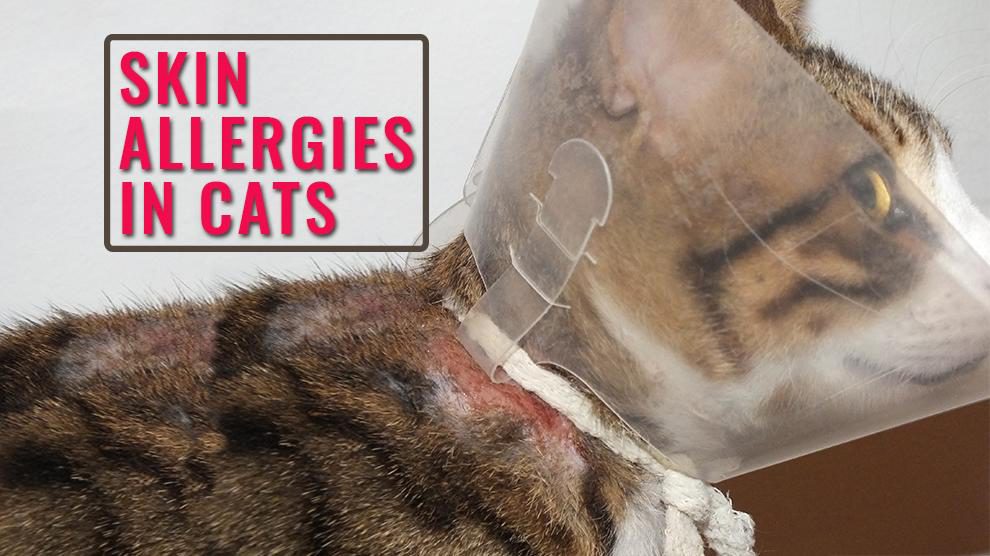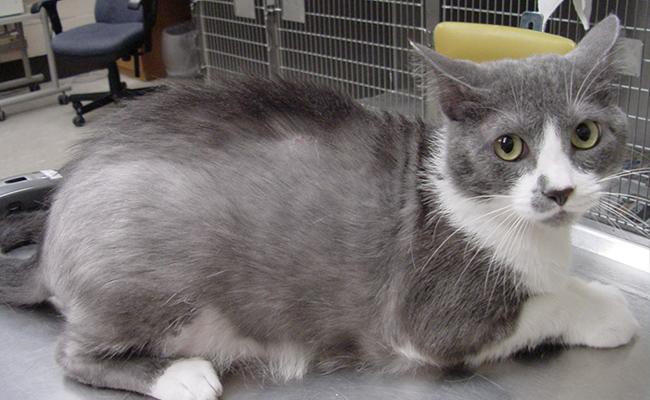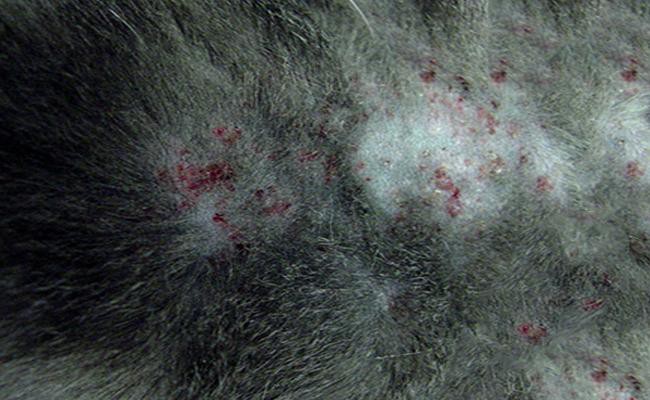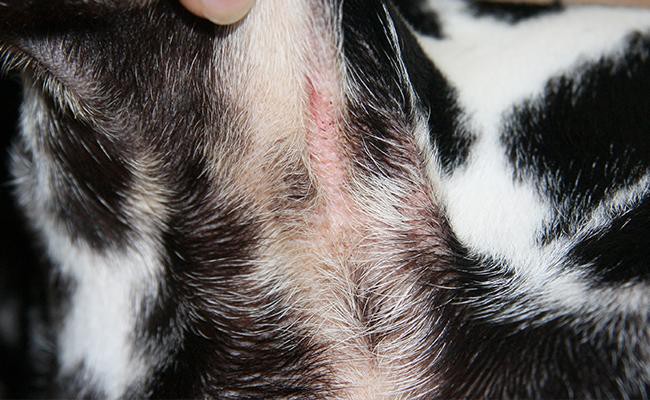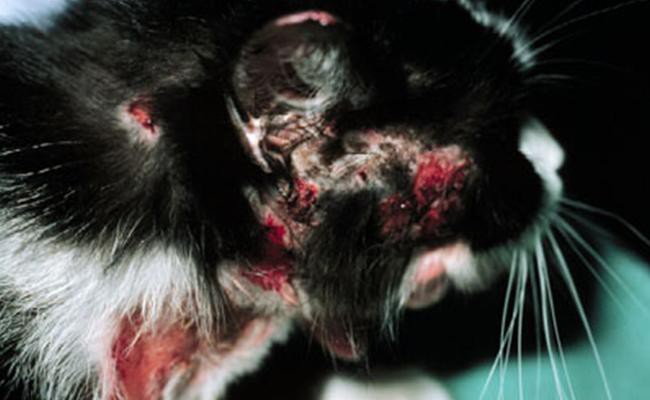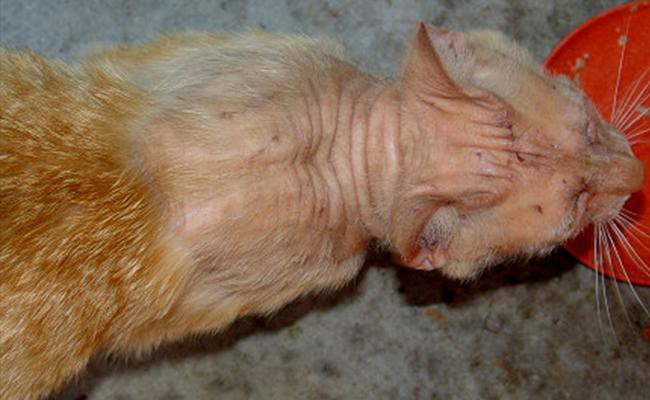Cat Pregnancy Calculator And Timeline
The skin allergies in the cat could be due to many reasons such as parasites like fleas, atopy or inhaled allergens, irritants in contact with skin, and allergy to food.
The cause of the skin allergy is analyzed by reviewing where and how the allergy manifested over the skin.
Generally, the place of allergy over the body and the pattern in which there is a hair loss are two main clues that help us in diagnosing the underlying reason for allergy.
A veterinarian does a complete diagnosis of the infections and eliminates the triggers one by one until he could conclude on a specific cause.
Categorizing Skin Allergies In Cat
The immune system releases a protein known as IgE as the allergens react with the cat’s skin or get into the cat’s body.
This particular protein comes in contact with the tissue mast cells in the cat’s skin and reacts to release histamine and other similar chemicals which leads to itches and rashes.
The skin allergies in a cat are broadly classified as follows
- Fleas
- Inhalant/ Contact Allergies
- Food Allergy
Flea Allergy Dermatitis
This is an allergy that is caused because of the sensitivity towards the flea’s saliva. As these blood-sucking fleas bite the cats they tend to spit their saliva. This saliva causes an allergy in cats.
Also, this allergy leads to certain secondary infections too.
Symptoms
- Serious itches
- Hot spots over face and hips
- Biting or chewing the tail and legs
- Lesions, oozing due to chewing
- Serious damage in the skin due to scratches
Treatment
- The immediate step is to remove the fleas that are around the cat. If you are controlling and removing the fleas using spray control make sure the eradication process does not affect the cat’s health condition. Keeping a check on the fleas in the surrounding by continuous vacuuming and cleaning of carpets to keep the cat away from flea eggs.
- Check with the veterinarian immediately if the cat has any secondary skin allergies and lesions. The vet may prescribe antifungal and antibiotics drugs if required.
- If the cat suffers from severe itching and seems to be highly uncomfortable, the asteroid of short course may be necessary to control the itching.
Contact Allergies
This is a type of allergy which is caused due to inhalation or absorption of allergens such as pollen, dander, etc. It releases inflammatory/ noncontagious disease allergic dermatitis or atopy.
It may also cause pruritus which affects the anal region with chronic itchiness.
Symptoms
- Mutilated skin
- Heavy hair loss
- Twitchy skin
- Tufts of hair pulled out
- Lengthy, red lesions
- Eosinophilic plaques
- Crusty papules
Treatment
- This is a kind of cat allergy that doesn’t require any specific treatment. If the cat tends to be allergic to any particular seasonal tress’s pollen, it would just take about 3 to 4 days to recover.
- All you need to do is to take certain simple yet important precautionary measures such as vacuuming by keeping the cat far, sheltering the cat in an uncarpeted hall, regular washing of the beds, avoiding basements to keep the cats, usage of air conditioners, keeping away from stuffed toys and pet foods that are dusty and also to keep a check on maintaining limited plants around the house.
- Topical therapy could be tried wherein the cat is cleansed completely using a shampoo and a topical anti-itch solution is applied. This gives the cat immediate relief for a short period.
- If any secondary and bacterial infections tend to develop, a visit to the vet is recommended.
Appearance Of Cat Skin Allergies
There are various types of feline skin allergies that affect cats. Due to this a vet tries to diagnose the cat’s skin by analyzing the condition categorized in about 4 different patterns.
Though the pattern is not used to determine a specific diagnosis it would help in understanding the type of skin disease or the condition which is troubling the cat.
Cat Military Dermatitis (Papulcrustous Dermatitis)
It is a skin allergy that is usually seen in the cat’s back however it may also affect any other body part of the cat. It is generally accompanied by few other cat skin infections such as allergy to flea bites.
Feline symmetrical alopecia
This skin allergy causes spotty patterns along with the short stubby hair in the cat. The cat tends to lick its hair which appears as though the cat’s hair is falling all over.
It is a condition that generally appears on the belly of the cat, rear legs, and side parts of the lower abdomen. This condition generally doesn’t affect the back of the cat.
Eosinophilic granuloma complex
There are certain reasons which could cause this condition which includes:
- The slow growth of ulcer (indolent)
- Eosinophilic plaque: highly defined, increased, ulcerated, and severely itchy (pruritic) lesions which appear on the cat’s skin generally the abdomen or hind legs.
Eosinophilic Granuloma
It is a collective term titled for the lesions( infected patch of skin) of eosinophilic ulcer ( a cut on the lip of the cat), eosinophilic plaque (lesions that appear on the skin generally over the abdomen or hind legs), and linear granuloma (tiny nodules on the skin).
This is generally due to the allergic infection caused by some element in the cat’s surroundings, fleas, and diet.
Head and neck pruritus (inches)
This is an allergic reaction that leads to itches in the lead and neck areas of the cat. There is a tendency of hair loss and severe skin damage which is caused because of itching.
Breakages in skin and cheeks may also appear. However, the vets consider that this is caused due to an infection by the herpes virus after being administered a vaccine to the cat.
Food Allergies
There is a difference in the concept of food allergies and food intolerance. Food allergies are generally accompanied by certain signs like itchiness and skin issues. But, food intolerance has signs of vomit sensation and diarrhea.
According to researches fish, dairy items, and beef are the usual offenders in this type. Even though most of the proteins are the same, there are certain types of proteins that are antigenic compared to others.
Allergic reactions could be determined based on the quantity of protein being exposed to.
Symptoms
- Skin itchiness
- Military dermatitis
- Loss of hair
- Skin scratching
The food allergy symptoms are not specific to any period it is seen almost throughout the year. However, it develops much during the winter which is not in the case of other allergies.
Treatment
- If the condition is diagnosed correctly, treating it is quite easy and simple. You may choose a specific cat food available for this purpose or draft a diet plan on your own for the cat.
- If you are planning a diet on your own, you can try the elimination technique by cutting down the food items slowly one after the other to conclude with the allergic food the “the culprit’.
- For example, you can try a vegetable diet and chicken diet for about a week or two and check for any allergic symptoms. If not, try beef for another two weeks and see if there is any change.
- If the cat seems to develop allergic reactions to pork then avoid pork from the cat’s food and understand that your cat is allergic to pork.
- Make sure to prepare a properly balanced diet for the cat which has a correct proportion of vitamins and minerals.
Generally, people don’t consider allergies as a serious problem which is a big blunder. Though allergies may not be fatal on their own, the complexities they may cause in the health may end up fatal.
Considering its serious side effects it is important to take adequate care of the pet for its healthy life.
Causes Of The Skin Allergies In Cat
In case the skin appearance of the cat is similar to any of the above patterns there are high chances the following may be caused to it:
- Cat Skin Allergies
- Flea Allergy
- Inhalant/ contact allergy
- Food allergy
- Parasite Problem
- Lice
- Otodectes cynotis
- Trombicula spp and Demodex spp
- Bacteria infection
- Fungus infection
- Idiopathic (unknown infection)
- Caused by behavioral problems
Cat Skin Allergy Diagnosis
Usually, the vet diagnoses the skin allergy in the cat by the elimination process.
The vet generally treats the allergy by the cause he/she thinks is closely related to the infection, later as the treatment progresses they conclude on the reason for the allergy.
Generally to begin with the vet analyzes if there is any parasitic allergy (fleas) later they check for food allergies in the animal.
To determine it is a flea allergy the vet checks around for any suspect of fleas wherein there are chances of specs falling as the cat is combed with a flea comb.
If any fleas are found in the cat’s skin then medicines to eradicate the fleas are administered to the cat. Usually, the fleas are found over the top of the tailor over the neck area.
Next is the parasite, mites found in the cat’s surroundings that may cause allergic skin infections. This kind of allergy is usually caused by Otodectes cynotis a mite species.
To understand if the allergy is through food the vet tries eliminating the foods by grouping them and sees the reaction of the cat and the allergy after the elimination.
Finally, after all these steps if the vet is still unable to conclude the reason behind the allergy caused in the cat, then he/she would recommend an allergy test.
The allergy test helps in understanding the reason and cause of the skin allergy and also helps in determining the allergens in the cat’s surroundings.
Cat Breeds With Skin Allergies
Siamese cat
If the cat’s skin changes from being glossy it is to be analyzed. Scabs, itchiness, soreness, reddishness, hair loss are to be certain symptoms to be given importance and discussed with a vet immediately.
Parasitic skin disease – The vet usually looks for parasitic infections in this cat breed. The parasites feed on the cat’s blood and the skin surface which leads to heavy itching. Apart from this infection due to parasites cause scabs and sores too.
Allergic skin disease – Parasites and their saliva or poop may cause allergic infections in the cat’s skin. But remember!!! Parasites are not the only cause of skin allergies.
Skin allergies could be caused by many other things in the surrounding. For example pollen, dust, mites, fragrances, and many more.
Skin infections – The infections in the skin in this breed are usually caused by a bite or scratch by the cat. Any damage caused by the cat to the outer layers of its skin usually leads to bacteria growth and in turn causes infection.
Keep a check on the soreness of the skin and change in the skin texture in this breed to treat the cat immediately and prevent any severe infection.
Persian Cat
Skin problems in Persian cats are quite common. They have full and amazing coats which tend to be ruined due to skin issues. There are certain skin problems that cause severe skin irritation and discomfort.
Skin Lesions due to fungal infections – Fungal infection is the most common skin infection in Persian cats which may even turn fatal.
Antibiotics don’t do much good in case of fungal infections so specific treatments for the same are necessary. The weaker immune system makes it more susceptible for the cat to be infected with fungal infection.
Ringworm and lesions due to yeast infection: Ringworm is nothing but a fungal infection that has less severity. Ringworms usually are small lesions that don’t have any hair over them.
They have scaly red sores. The lesions, on the other hand, do not have any particular shape and spread over the face. This is treated with a topical cream.
Parasitic skin problems – Ear mites, ticks, and fleas are small parasites that create huge problems in the cat. Severe discomfort and itchiness are caused as fleas infest the cat.
Ticks tend to bury underneath the skin and suck the blood completely. Removing the tick completely is the only solution.
Food allergies – The third most common skin problem in Persian cats is food allergies. This leads to itchiness in the cat’s skin.
Maine Coon
Maintaining this breed is very simple yet there are circumstances when this breed gets severely affected due to skin problems.
Flea Allergy – Maine coon is affected mainly by flea allergy. As this cat breed has long hair it is a bit complicated task to observe the flea infection in them.
The flea dermatitis caused by the flea bites and its saliva affects the cat’s skin severely. The major signs of this infection are hair loss and reddish bumps across the skin.
Atopic dermatitis – Another major skin allergy that affects this cat breed is atopic dermatitis. As these cats have lengthy hair dust, moisture and bacteria tend to get accumulated in their skin and lead to illness.
To be precautious from this infection it is better to brush and clean this cat regularly.
Apart from the above the Maine coon cats also have skin allergic reactions due to wheat gluten food, cleaning materials, pollens, plastics, dairy products, essential oils, and perfumes.
Savannah Cat
This domestic cat with spots is prone to two major types of hypersensitivity reactions. The immediate reaction caused due to the allergy is hives and itching.
Food allergy – Cats tend to have allergies due to certain foods or certain ingredients present in the food. Fish, cheese, and milk are the most common allergens for this breed.
Severe itchiness in the skin may occur. The cat may suffer from sneezing, eyelids swelling, and running nose.
Flea allergy dermatitis – It is one of the seasonal allergies which occur in this breed. Most of the signs of this allergy are seen in summer. Once the rashes and fleas are found in the cats make them stand on a plain sheet of paper ruff up the fur.
It is advised to kill the fleas by any of the topical or ingestible killers as advised by the vet.
This breed tends to be allergic to certain chemical substances as well which includes acids, detergents, soaps, solvents, and petroleum products. Shampoos, plastics, dyes in the carpet are few other substances that could cause allergic dermatitis.
British short hair
British Shorthair cat is a quiet, independent, and excellent companion which has a short, easy maintenance coat. Most of the illness in this breed is due to genetic problems.
Most of the worms and bugs can take a toll on the Brit’s skin both from within and outside. Almost all from fleas, ticks, and ear mites seem to infest the skin and ears of this breed.
Hookworms, roundworms, whipworms, and heartworms infect this cat’s health in various ways. These infections are usually because of the consumption of unclean water, walk-in-contaminated mud, or mosquito bites.
Beware!!!! The allergies in these cats could cause a threat even to your family and neighbors. The British Shorthair breed is quite sensitive to parasites and allergies that it gives them severe pain and even ends fatally.
It’s always safe to get them regularly checked and treated if required. The allergies in this breed could be examined using stool samples so if you are visiting your vet it’s advised to carry a fresh stool sample in a stink-proof container to diagnose the allergy.
Overall Treatment For Allergies In Cat
When the actual cause of the allergy is diagnosed allergy shots can be given to the cat to reduce the severity of the allergy.
The antihistamine such as chlorpheniramine would be helpful in treating cats with allergies. They are widely proven to be effective.
If the cat seems to be allergic to food or has food intolerance the vet usually advises eliminating certain foods and helps us in finding the actual food which is allergic to the cat.
Vets also advise giving home-cooked food such as chicken and rice which are much healthier and safer than the supplements for the cat.
Although it isn’t possible practically to eliminate all that causes allergy to the cats from the environment, it is better to keep a check and avoid to an extent all the allergens from the cat.
Prevention - Caution!!!
- Is your cat allergic to fleas??? Then prevention is the only precaution. It is better to keep a flea control treatment handy with the advice of a vet. Make sure to take the advice of the vet for a good flea control product before the season starts.
- Keep the surroundings dust-free and unscented litter. At times the chemical particles in the scented litter also cause severe allergies in cats.
- Dust could also cause allergies in cats if that’s the case keep a check on your dusting schedule. Make sure to dust everything around like curtains, rugs, and beds, at least once a week, and vacuum clean the house using a cleaner at least twice a week.
- Bath the cat regularly maybe twice weekly as it helps in maintaining the skin of the cat and removing the allergens from the skin such as pollen, dust, etc… Also, request the vet to prescribe a good shampoo for the cat as frequent bathing or using the wrong soap may worsen the allergy.
- If the food intolerance is the cause of allergy the cat may be put on a specific diet that is to be strictly followed or the cat may be introduced to hydrolyzed protein diet.
Never ignore or be careless about the allergies in the cat. Visit a vet, take their advice and together help your pet fight the allergy and tackle the skin reactions in the pet successfully.

